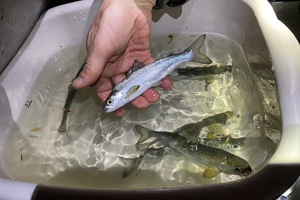Tamar salmon tagged to provide vital data on health of fish stocks
The Environment Agency has completed the mammoth task of tagging more than 4,000 juvenile salmon smolts (juveniles) before they leave the River Tamar and head out to sea.

Small fish being held above a bowl containing several small fish
Fisheries experts have also fin clipped nearly 900 sea trout smolts, so they can be identified when they return to the Tamar.
Salmon and sea trout are monitored intensively on the River Tamar to provide information on the biology and status of stocks. The Tamar is one of 3 index rivers in England and Wales, but the only index river reporting on the marine survival rates of salmon and sea trout.
Some 4,093 salmon smolts, heading out to sea as part of their migration to their adult feeding grounds at sea, were trapped using the Environment Agency’s rotary smolt trap on the River Tamar.
Fisheries experts then carefully injected a tiny tag (size of an iron filing) into their nose cartilage. This tag can be detected in any adult fish that return to the Tamar and are caught in the fish trap at Gunnislake. The information can then be used to calculate marine survival rates.

Small fish being held while tag carefully put in its nose
Sea trout smolts are tagged or fin-clipped on alternate years to distinguish between the different age classes and calculate marine survival rates. Although it is interesting to get reports of tagged or fin-clipped fish from anglers, only data collected from the adult trap at Gunnislake is used to calculate marine survival rates and it’s preferable that any fish caught are returned to the water as soon as possible.
Paul Elsmere, Environmental Monitoring Officer for the Environment Agency, said:
This information is vitally important and provides vital data on the health of our salmon stocks, and is used to inform both national and international salmon management and conservation measures.
Salmon are key indicators of climate change and are considered by many to be the perfect barometer for measuring the health of our oceans and rivers as they have life stages in both environments.
Climate change, including extreme weather events, pollution, increasing sea temperatures, and a range of other man-made problems have all had a major – negative - impact on salmon populations.
Since the Tamar index river programme started in 2004 we have recorded significant changes in run timing, stock structure, body size and condition, juvenile recruitment and the emergence of new diseases and conditions, all of which can be linked to climate change.